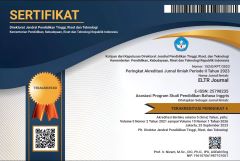THE ANALYSIS OF DENOTATIVE AND CONNOTATIVE MEANING OF INDONESIAN SEXIST METAPHORS
Abstrak terlihat: 552 / PDF terunduh: 707DOI:
https://doi.org/10.37147/eltr.v3i2.90Keywords:
sexist metaphors, denotative meaning, connotative meaningAbstract
This research was conducted to analyse the denotative and connotative meaning of Indonesian sexist metaphors. The metaphors were collected from various sources, such as online sources, Indonesian Dictionary (KBBI), song lyrics, poems, movies, and newspaper. There were two research questions formulated as follows: 1) What are the Indonesian sexist metaphors? and 2) What are the denotative and connotative meaning of the sexist metaphors? The method of this research was qualitative method, specifically content analysis. This method has two sources, they are primary and secondary sources. The primary source was the metaphors found in various sources. The secondary sources were theories of metaphor, denotative and connotative meaning, and sexist language. The metaphors were analysed using Lakoff and Johnson’s theory (1980) and the meaning of the metaphor was analysed using Parera’s theory (2004). In identifying the sexist in the metaphor, this study used the sexist language theory from Mills (1995). The results of this research showed that there were 32 Indonesian sexist metaphors, 16 of which belonged to female and the other 16 to male. Each metaphor had both connotative and denotative meanings. Based on the findings, it could be concluded that Indonesian language has sexist metaphors for both male and female.
Downloads
References
Arp, T. R. & Johnson, G. (2009). Perrine’s literature (10th ed.): Structure, sound, and sense. Boston: Wadsworth Cengage Learning.
Ary, D., Jacobs, L. C., & Sorensen, C. (2010). Introduction to research in education. Belmont: Wadsworth.
Blaxter, L., Hughes, C., & Tight, M. (1996). How to research. Buckingham: Open University Press.
Jati, L. J. (2018). An analysis of metaphors found in Bring Me the Horizon’s selected song lyrics. Yogyakarta: Teacher Training and Education Faculty, Department of Language and Arts Education, English Language Study Program, Sanata Dharma University, Retrieved May 20, 2019, from repository.usd.ac.id
Lakoff. G. & Johnson, M. (1980). Metaphor we live by. Chicago: University of Chicago Press.
Mills, S. (1995). Feminist stylistics. New York: Routledge.
Mooij, J. J. A. (1976). A study of metaphor: On the nature on metaphorical expression with special reference to their reference. Amsterdam: North-Holand.
Myres, M. D. (2009). Qualitative research in business management. Thousand Oaks, CA: Sage Publications Ltd.
Nneka, U. O. (2012). Linguistics sexism: An overview of the English language in everyday discourse. An International Journal of Language, Literature and Gender Studies, 1-17.
Parera, J. D. (2004). Teori semantik (2nd ed.). Jakarta: Erlangga.
Silverman, K. (1983). The subject of semantics. New York: Oxford.
Wilden, A. (1987). The rules are no game: The strategy of communication. London: Routledge.
Yenni. (2013). Gender stereotyping shown by sexist language in Phyllida Lloyd’s the Iron Lady. Yogyakarta: Faculty of Letters, Departmnt of English Letter, English Letters Study Programme, Sanata Dharma University, Retrieved in May 23, 2019, from repository.usd.ac.id.
Downloads
Published
How to Cite
Issue
Section
License
Copyright (c) 2020 Tutur Nur Utami, Putriahyana Sucianingrum, Patricia Marceline P.G.T.

This work is licensed under a Creative Commons Attribution-ShareAlike 4.0 International License.













